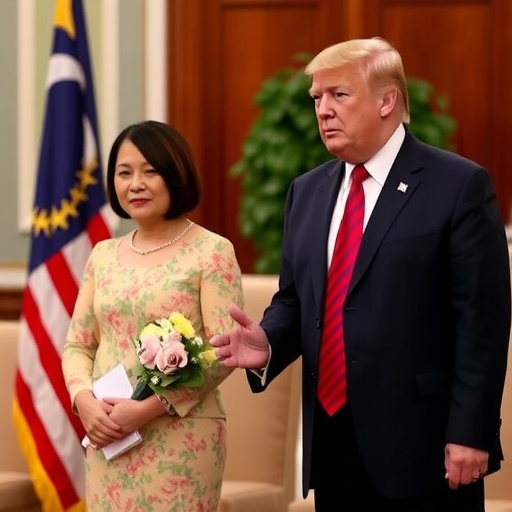Trump Strengthens Asia Diplomacy at ASEAN Summit in Malaysia, Witnesses Thailand-Cambodia Peace Milestone
In a pivotal moment for regional stability, President Donald Trump attended the ASEAN Summit in Kuala Lumpur, Malaysia, where he personally witnessed the historic signing of a peace agreement between Thailand and Cambodia. This event, part of Trump‘s ambitious three-nation Asian tour, underscores the U.S. commitment to fostering peace and countering emerging threats in the Asia-Pacific region amid rising tensions.
- Historic Peace Deal: Thailand and Cambodia Seal Border Accord Under Trump’s Watch
- Trump’s Summit Engagements: Tackling Regional Security Challenges Head-On
- Broadening Horizons: Trump’s Three-Nation Tour and U.S. Strategic Interests in Asia
- Expert Insights: How the Summit Shapes Future U.S.-ASEAN Ties
- Looking Ahead: Pathways for Enhanced Stability and Cooperation
The summit, hosted in the bustling capital of Malaysia, brought together leaders from the 10 ASEAN member states to address pressing issues in Asia diplomacy and regional security. Trump’s presence highlighted a renewed U.S. focus on Southeast Asia, a region critical for global trade routes and containing hotspots like the South China Sea. As the world watches, this visit signals a strategic pivot in American foreign policy, emphasizing partnerships over isolationism.
During the ceremonies, Trump engaged in bilateral meetings, applauding the peace deal that resolves decades of border disputes between the two nations. “This is a triumph of diplomacy and a model for the world,” Trump stated in a brief address, according to White House officials. The agreement, brokered under ASEAN mediation, includes provisions for joint border patrols and economic cooperation zones, potentially unlocking billions in trade opportunities.
Historic Peace Deal: Thailand and Cambodia Seal Border Accord Under Trump’s Watch
The signing of the Thailand-Cambodia peace agreement marked a high point of the ASEAN Summit in Malaysia. Long-standing tensions over the Preah Vihear temple and surrounding territories had flared into armed skirmishes as recently as 2011, resulting in dozens of deaths and displacing thousands. ASEAN’s role in facilitating talks since 2018 has been instrumental, with neutral observers from Indonesia and Malaysia playing key mediation roles.
Trump’s attendance added significant international weight to the proceedings. Arriving via Air Force One at Kuala Lumpur International Airport, the President was greeted by Malaysian Prime Minister Anwar Ibrahim with full ceremonial honors. In his remarks following the signing, Trump emphasized the U.S. support for the deal, pledging $50 million in development aid to both countries for infrastructure projects along the border. This aid package includes funding for roads, schools, and water management systems, aimed at preventing future conflicts through economic interdependence.
Experts hail the agreement as a breakthrough. Dr. Lina Lim, a Southeast Asia specialist at the Brookings Institution, noted, “The involvement of a global power like the U.S. under Trump lends credibility and ensures long-term enforcement. It’s a win for regional security, reducing the risk of proxy conflicts in an already volatile area.” Statistics from the ASEAN Secretariat reveal that border disputes have historically cost the region over $2 billion annually in lost trade and security expenditures; this peace could reverse that trend.
Behind the scenes, the negotiations were intense. Cambodian Prime Minister Hun Manet and Thai Prime Minister Srettha Thavisin exchanged documents in a symbolic gesture, with Trump standing as a witness alongside other ASEAN leaders. The accord outlines demilitarization of a 4.6-square-kilometer disputed zone and establishes a joint commission for ongoing dispute resolution. This development not only stabilizes the immediate area but also sets a precedent for resolving similar issues in the region, such as those in the Mekong River basin.
Trump’s Summit Engagements: Tackling Regional Security Challenges Head-On
Security dominated the agenda at the ASEAN Summit, with Trump leading discussions on pressing threats including cyber warfare, maritime disputes, and non-traditional security issues like climate change-induced migration. In a plenary session, Trump advocated for enhanced U.S.-ASEAN military cooperation, proposing joint exercises to bolster defenses against external aggressions—widely interpreted as a nod to China’s assertive claims in the South China Sea.
The South China Sea remains a flashpoint, with overlapping claims by Brunei, Malaysia, the Philippines, Vietnam, and others. According to a 2023 report by the Center for Strategic and International Studies, illegal fishing and resource extraction in the area have escalated, leading to over 100 naval incidents last year alone. Trump reiterated the U.S. freedom of navigation operations, stating, “America stands with our allies to ensure open seas and fair trade. No one nation can dictate terms in these vital waters.”
Bilateral talks with Malaysian leaders focused on counterterrorism, given Malaysia’s strategic position in combating extremist networks. The U.S. announced a new intelligence-sharing pact, building on the Five Eyes alliance model, to monitor threats from groups like ISIS affiliates in the region. Additionally, discussions touched on supply chain resilience post-COVID, with Trump pushing for diversification away from single-country dependencies—a subtle critique of over-reliance on Chinese manufacturing.
Quotes from summit participants underscored the collaborative spirit. Singapore’s Prime Minister Lawrence Wong remarked, “President Trump’s engagement revitalizes Asia diplomacy, showing the U.S. is back as a reliable partner.” Data from the U.S. Trade Representative indicates that U.S.-ASEAN trade reached $400 billion in 2023, up 15% from the previous year, highlighting the economic stakes in these security dialogues.
To illustrate the breadth of topics, here’s a breakdown of key security pacts discussed:
- Maritime Security Initiative: Expanded U.S. naval training for ASEAN navies, including Malaysia’s, to patrol contested waters.
- Cyber Defense Framework: A new ASEAN-wide protocol for sharing cyber threat intelligence, with U.S. tech firms like Microsoft contributing expertise.
- Disaster Response Coalition: Joint preparedness for typhoons and floods, which have displaced millions in the region annually.
These initiatives reflect Trump’s pragmatic approach, blending hard power with soft diplomacy to address multifaceted regional security concerns.
Broadening Horizons: Trump’s Three-Nation Tour and U.S. Strategic Interests in Asia
Trump‘s visit to Malaysia is the centerpiece of a three-nation tour that also includes stops in Japan and South Korea, aimed at fortifying alliances in the face of geopolitical shifts. This itinerary follows Trump’s first-term emphasis on the Indo-Pacific strategy, which allocated over $100 billion in investments to the region between 2017 and 2021. The current tour builds on that legacy, with announcements of $20 billion in new trade deals and defense contracts.
In Japan, Trump is expected to reaffirm the U.S.-Japan security treaty, focusing on missile defense against North Korean threats. South Korea discussions will center on trilateral cooperation with Japan to deter Pyongyang’s nuclear ambitions. But the ASEAN Summit stop in Malaysia uniquely positions the U.S. in Southeast Asia, a subregion often overshadowed by Northeast Asian flashpoints.
Contextually, U.S. Asia diplomacy has evolved under Trump. Unlike multilateral forums like the CPTPP, which the U.S. declined to join, this tour emphasizes bilateral ties. A White House briefing noted that since 2021, U.S. diplomatic engagements in ASEAN have increased by 30%, with embassy expansions in Hanoi and Jakarta. Economically, the U.S. is the third-largest trading partner for ASEAN, trailing only China and the EU, with potential for growth in semiconductors and renewable energy sectors.
Challenges persist, however. Analysts point to domestic U.S. priorities, like inflation and midterm elections, potentially diluting focus on Asia. Yet, Trump’s personal style—marked by direct, deal-making rhetoric—resonates in the region. As one Malaysian diplomat confided to Reuters, “Trump’s unpredictability is an asset; it keeps adversaries guessing.”
The tour’s timeline includes cultural exchanges, such as Trump’s visit to Kuala Lumpur’s Petronas Towers and a state dinner featuring Malaysian delicacies, humanizing the diplomacy. These elements foster goodwill, essential for long-term partnerships.
Expert Insights: How the Summit Shapes Future U.S.-ASEAN Ties
Reactions from global experts illuminate the summit’s ripple effects on regional security and Asia diplomacy. At a post-summit panel hosted by the Council on Foreign Relations, panelists praised Trump’s hands-on approach. “By witnessing the peace signing, Trump has elevated ASEAN’s role in global affairs,” said Ambassador Ret. Susan Schwab, former U.S. Trade Representative.
Quantitative impacts are emerging. A projected 10% boost in intra-ASEAN trade from reduced border frictions could add $15 billion to regional GDP by 2025, per ASEAN economic forecasts. On security, the U.S. commitment to provide advanced radar systems to Malaysia enhances surveillance capabilities, deterring incursions in the Malacca Strait—a chokepoint for 40% of global oil trade.
Critics, however, urge caution. Some in the region worry about U.S.-China rivalry escalating. Beijing’s foreign ministry responded to the summit with calls for “inclusive dialogue,” hinting at countermeasures. Nonetheless, Trump’s tour positions the U.S. as a counterbalance, appealing to nations seeking diversified partnerships.
In-depth analysis reveals layered motivations. For Malaysia, hosting the summit boosts its international profile, aligning with its 2025 ASEAN chairmanship goals. For Trump, it’s a platform to showcase diplomatic wins ahead of domestic challenges, reinforcing his narrative of American strength abroad.
Looking Ahead: Pathways for Enhanced Stability and Cooperation
As the ASEAN Summit concludes, the path forward for Trump‘s Asia diplomacy points to sustained engagement. Upcoming U.S.-ASEAN summits in 2024 will build on Kuala Lumpur’s momentum, potentially expanding the peace framework to other disputes, like those in the Spratly Islands.
Forward-looking initiatives include a U.S.-backed green energy corridor linking ASEAN nations, addressing climate security—a growing concern with sea levels rising 3.7 mm annually in the Pacific. Investment in digital infrastructure could create 1 million jobs by 2030, per World Bank estimates, while fortifying against cyber threats.
Trump’s tour wraps with promises of follow-up visits and virtual leader dialogues, ensuring continuity. For regional players, this signals a reliable U.S. presence, crucial amid uncertainties. As Malaysia’s Anwar Ibrahim put it, “Together, we forge a secure and prosperous future.” The summit’s outcomes could redefine regional security dynamics, paving the way for a more integrated Asia-Pacific.









